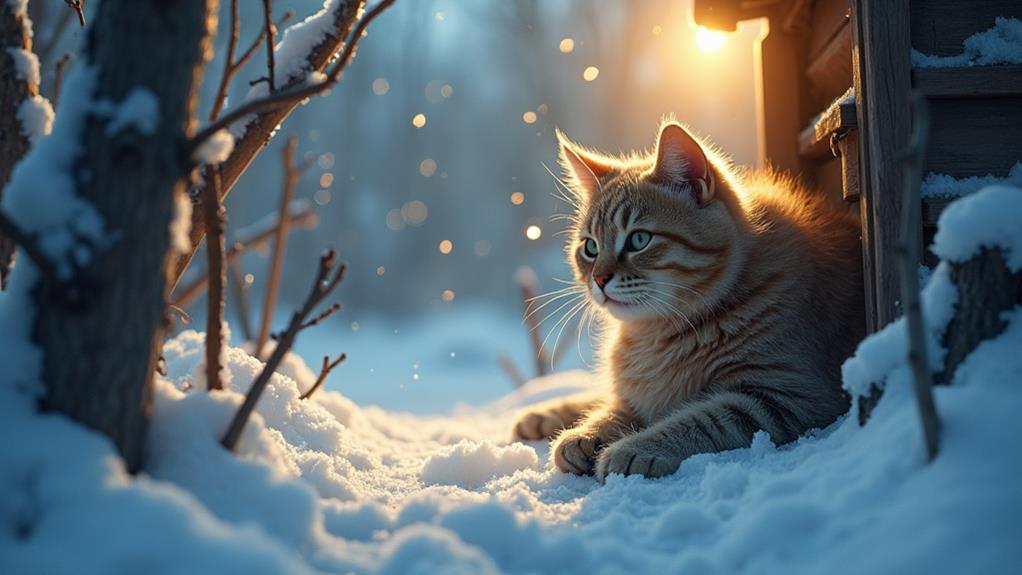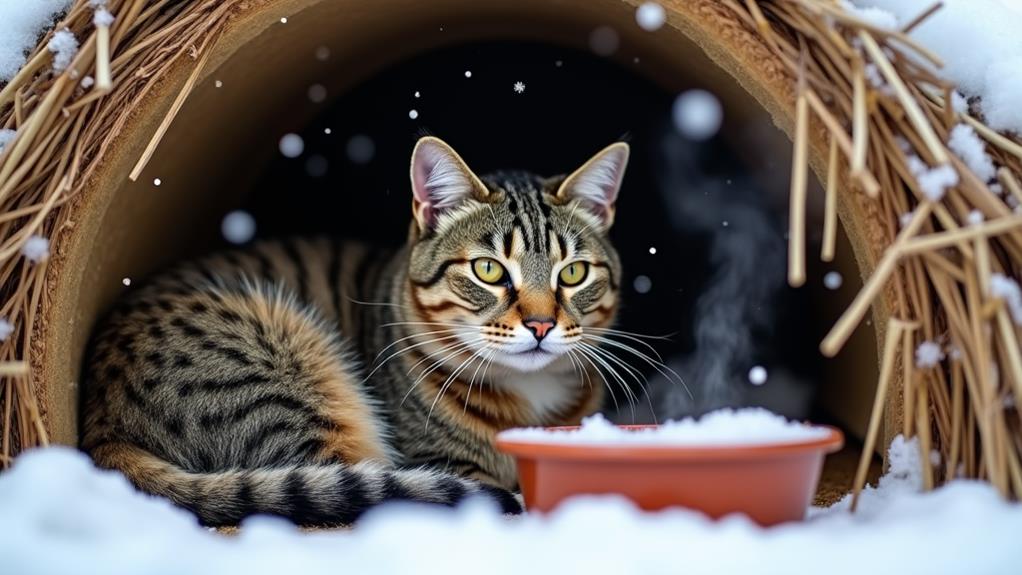How Cold Is Too Cold for a Feral Cat? Winter Safety Tips

When temperatures fall below 45°F, feral cats become susceptible to cold stress and require adequate shelter to stay safe. At 32°F or lower, hypothermia becomes a real risk, while exposure to 20°F can even lead to frostbite. Make certain they're protected with insulated shelters raised off the ground, using straw for bedding. Feed them high-calorie canned food to fuel their energy, and use insulated bowls to keep water from freezing. Community involvement can make a big difference, providing vital resources and support. To fully understand how to protect feral cats during winter, there's more to uncover.
Recognizing Dangerous Temperatures
Recognizing dangerous temperatures is crucial for ensuring the safety of feral cats during the winter months. When cold temperatures hit, feral cats are at risk of hypothermia, especially when it drops below 32°F (0°C). At this point, their body heat struggles to keep up, and they can only endure for a few days without adequate shelter. The pivotal temperature to provide adequate shelter is 45°F (7°C). Below this, feral cats become increasingly vulnerable to cold-related health issues.
Look for signs of cold distress such as shivering, lethargy, and cold extremities. These indicate that a cat needs immediate warmth and shelter. Hypothermia sets in if their body temperature falls below 99°F (37.2°C), a condition that can develop quickly in severe cold. Keeping your outdoor cats safe means being vigilant during chilly spells. Prolonged exposure to temperatures around or below 20°F (-6°C) can lead to frostbite and greatly increase the risk of death.
Feral cats rely on you to recognize these dangerous conditions and act swiftly. By understanding these pivotal temperatures, you play a key role in their survival during harsh winter weather.
Providing Proper Shelter
Providing proper shelter for feral cats during the winter is vital to their survival. You should consider creating insulated shelters that are at least 2x3 feet and 18 inches high. These dimensions help trap body heat effectively, keeping the feral cats warm as temperatures drop. To provide the best insulation, use straw rather than blankets. Straw doesn't absorb moisture, which means it won't chill the cats like damp blankets might.
Make certain each shelter has small entryways with flaps. This design helps block cold air while also providing protection against predators. Position these shelters raised off the ground. Doing so prevents dampness from seeping in, which is fundamental to maintain a dry, warm environment.
To accommodate more cats and give them options for privacy and safety, consider setting up multiple shelters. Harsh weather conditions can drive feral cats to seek refuge, and having several options guarantees they have a safe place to go. Regularly inspect and maintain these shelters for cleanliness and usability. A clean shelter is a safe shelter, offering feral cats a dependable sanctuary throughout winter's challenges. By taking these steps, you're actively safeguarding their well-being during the cold months.
Ensuring Nutritious Diets

When winter temperatures plummet, feral cats need extra nourishment to sustain their energy levels and body heat. To help them through these harsh months, provide extra food rich in calories. Canned food is a great option, as it's easier for cats to digest and offers the necessary nutrients they need. Incorporating fresh food into their diet is also beneficial, but remember to replace it daily.
Water is vital, too, and it's important to prevent it from freezing. Use insulated bowls to keep water liquid and accessible. Regularly check these bowls to guarantee feral cats always have access to hydration and nutrition. Establishing a consistent feeding schedule will help them rely on you for their daily needs, reducing their stress from food scarcity.
Keep an eye on the feeding areas to monitor any competition or aggression among the cats. Limited resources can lead to increased fighting, so make sure there's enough food and space for all. By taking these steps, you're not only meeting their nutritional needs but also helping them cope with the challenges winter brings. Your efforts can make a significant difference in their survival.
Managing Cold Weather Hazards
As you ensure feral cats receive the necessary nutrition to battle the cold, it's likewise essential to manage the hazards that winter brings. Feral cats face significant risks like hypothermia and frostbite when temperatures plummet below 32°F (0°C). Here's how you can improve their winter safety:
- Providing Shelter: Build insulated shelters for feral cats, ensuring they are raised off the ground. Use straw for insulation, as it offers warmth and keeps moisture at bay. This setup protects against wind, rain, and snow.
- Regular Feeding: During harsh winter conditions, feral cats need more energy to stay warm and hunt. Increase feeding frequency and provide high-calorie food to help maintain their energy levels.
- Monitoring Frostbite: Keep an eye out for signs of frostbite, such as discolored skin on their ears and paws. Addressing these symptoms promptly can prevent severe cold exposure damage.
- Cold Exposure Awareness: Be vigilant for symptoms like shivering, lethargy, and cold extremities. These indicate that the cats need immediate warmth and shelter.
Community Support and Resources

Many believe that enhancing feral cats' winter safety is a community effort. You can play a significant role in keeping these cats safe by joining forces with others. Community support is key to providing fundamental resources like shelters and guaranteeing feral cats receive food and water daily. By organizing events and workshops, you can educate residents about the importance of creating a compassionate environment for these animals.
Partnering with local animal welfare organizations can amplify your efforts. These organizations often have the expertise to set up feeding stations and implement Trap-Neuter-Return (TNR) programs, which are critical for managing feral cat populations. Sharing winter safety tips through social media can help spread awareness and rally more people to the cause.
Establishing clear communication channels within your community is another effective strategy. By encouraging neighbors to report the needs of feral cats, you can secure timely assistance and foster a sense of collective responsibility. This collective approach not only benefits the cats but also strengthens community bonds. Remember, every action you take contributes to a safer, more supportive environment for feral cats during the harsh winter months.
Winter Trap-Neuter-Return Strategies
Building on the community's collective effort, implementing effective Winter Trap-Neuter-Return (TNR) strategies is a practical step toward managing feral cat populations during the colder months. Winter weather poses unique challenges, but with careful planning, you can guarantee cat safety and success in your TNR efforts. Here's how:
- Warm Shelters: Guarantee there are adequate warm shelters available for feral cats post-surgery. This helps them recover safely and comfortably.
- Monitor Traps: During winter operations, frequently monitor traps to prevent cats from being exposed to extreme cold or adverse conditions. Quick action is vital to reduce stress and keep them safe.
- Schedule Wisely: Conduct TNR during the warmer parts of the day. This optimizes the cats' comfort and minimizes the stress associated with colder temperatures, facilitating a smoother surgical process.
- Leverage Community Support: Engage community support to gather resources and assistance. This is fundamental for the success of winter TNR initiatives, guaranteeing feral cats receive the care and protection they need.
Effective TNR during winter not only simplifies the surgical process due to fewer pregnant cats but also greatly contributes to controlling the feral cat population.




